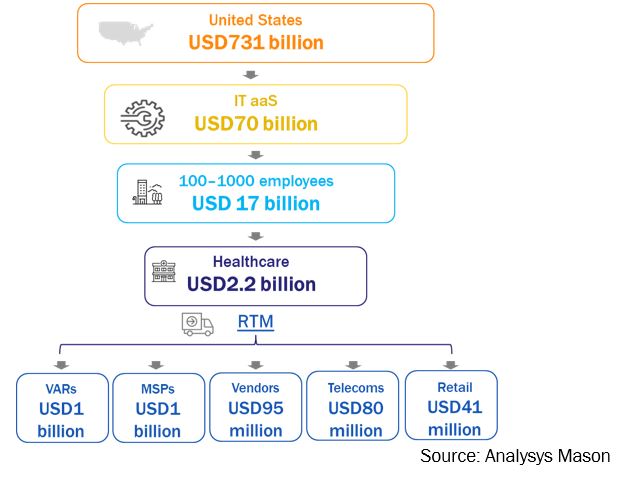We developed a market segmentation model to enable a global IT solutions vendor to execute its go-to-market investment strategy for its IT aaS solutions
Project experience | SMB IT
The problem
- Our client, a global OEM1 and IT solutions vendor, wanted to assess the market opportunity for its IT as-a-Service (aaS) portfolio. It sought to better understand the market size and growth potential in various verticals and channels to optimise the return on investment of its product roll-out
The solution
- To estimate the client’s market opportunity, we:
- leveraged Analysys Mason’s SMB2 Technology Forecaster vertical and routes-to-market (RTM) models to develop a custom total addressable market (TAM) for 15 unique product categories
- created an integrated model combining technology spending by 19 verticals through 5 channels using statistical modelling and applied in-house knowledge from our proprietary SMB technology surveys which include insights on SMBs' buying behaviour at an industry level, i.e. current usage and future plans
- conducted research to validate category-specific insights and growth drivers
Figure: Illustrative segmentation for spending on IT aaS

The result
- We developed market size estimates and forecasts for the client’s 15 solutions across 17 target markets, 14 business segments, 19 verticals and 5 channels (routes to market). The custom model delivered insights into the preferred purchase channels for each industry at all levels of granularity
- The client leveraged Analysys Mason’s custom model and advisory support to build its go-to-market strategy. The insights were used to make product roll-out investment decisions around key industry and channel segments
1 Original equipment manufacturer; 2 Small and medium-sized businesses
We helped a global IT solutions vendor to assess the market opportunity and execute its go-to-market strategy investments for its IT as a Service (aaS) portfolio by developing a custom market segmentation model

